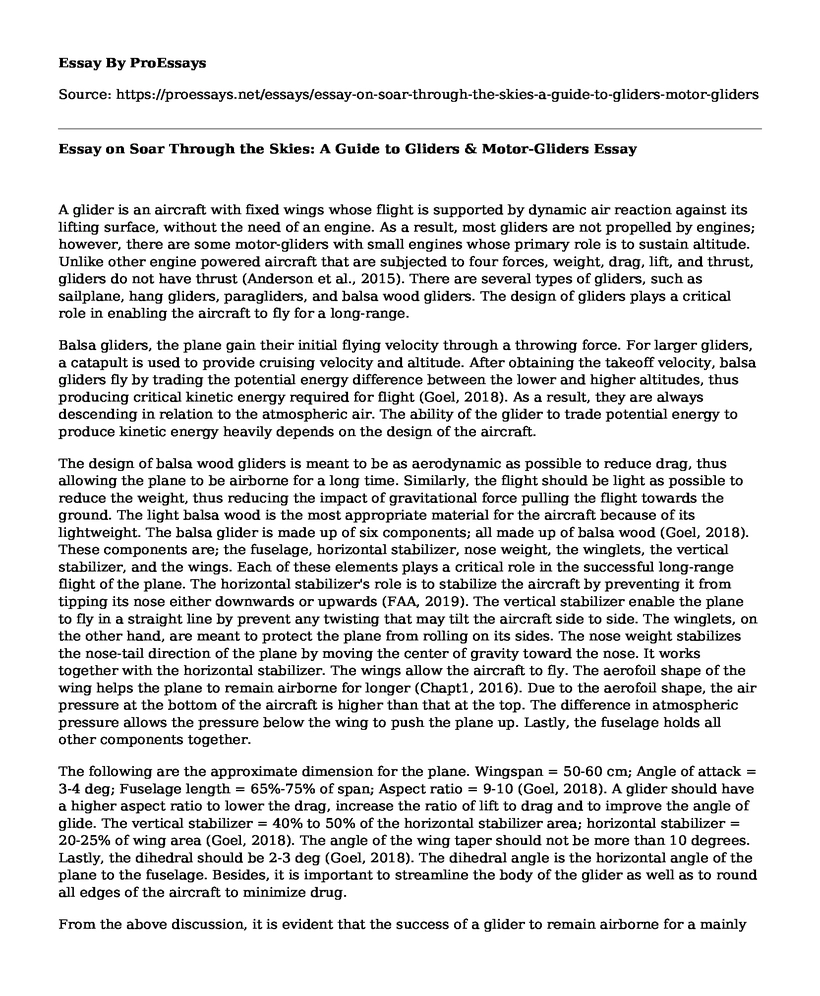A glider is an aircraft with fixed wings whose flight is supported by dynamic air reaction against its lifting surface, without the need of an engine. As a result, most gliders are not propelled by engines; however, there are some motor-gliders with small engines whose primary role is to sustain altitude. Unlike other engine powered aircraft that are subjected to four forces, weight, drag, lift, and thrust, gliders do not have thrust (Anderson et al., 2015). There are several types of gliders, such as sailplane, hang gliders, paragliders, and balsa wood gliders. The design of gliders plays a critical role in enabling the aircraft to fly for a long-range.
Balsa gliders, the plane gain their initial flying velocity through a throwing force. For larger gliders, a catapult is used to provide cruising velocity and altitude. After obtaining the takeoff velocity, balsa gliders fly by trading the potential energy difference between the lower and higher altitudes, thus producing critical kinetic energy required for flight (Goel, 2018). As a result, they are always descending in relation to the atmospheric air. The ability of the glider to trade potential energy to produce kinetic energy heavily depends on the design of the aircraft.
The design of balsa wood gliders is meant to be as aerodynamic as possible to reduce drag, thus allowing the plane to be airborne for a long time. Similarly, the flight should be light as possible to reduce the weight, thus reducing the impact of gravitational force pulling the flight towards the ground. The light balsa wood is the most appropriate material for the aircraft because of its lightweight. The balsa glider is made up of six components; all made up of balsa wood (Goel, 2018). These components are; the fuselage, horizontal stabilizer, nose weight, the winglets, the vertical stabilizer, and the wings. Each of these elements plays a critical role in the successful long-range flight of the plane. The horizontal stabilizer's role is to stabilize the aircraft by preventing it from tipping its nose either downwards or upwards (FAA, 2019). The vertical stabilizer enable the plane to fly in a straight line by prevent any twisting that may tilt the aircraft side to side. The winglets, on the other hand, are meant to protect the plane from rolling on its sides. The nose weight stabilizes the nose-tail direction of the plane by moving the center of gravity toward the nose. It works together with the horizontal stabilizer. The wings allow the aircraft to fly. The aerofoil shape of the wing helps the plane to remain airborne for longer (Chapt1, 2016). Due to the aerofoil shape, the air pressure at the bottom of the aircraft is higher than that at the top. The difference in atmospheric pressure allows the pressure below the wing to push the plane up. Lastly, the fuselage holds all other components together.
The following are the approximate dimension for the plane. Wingspan = 50-60 cm; Angle of attack = 3-4 deg; Fuselage length = 65%-75% of span; Aspect ratio = 9-10 (Goel, 2018). A glider should have a higher aspect ratio to lower the drag, increase the ratio of lift to drag and to improve the angle of glide. The vertical stabilizer = 40% to 50% of the horizontal stabilizer area; horizontal stabilizer = 20-25% of wing area (Goel, 2018). The angle of the wing taper should not be more than 10 degrees. Lastly, the dihedral should be 2-3 deg (Goel, 2018). The dihedral angle is the horizontal angle of the plane to the fuselage. Besides, it is important to streamline the body of the glider as well as to round all edges of the aircraft to minimize drug.
From the above discussion, it is evident that the success of a glider to remain airborne for a mainly long-range depends on its design. While designing a balsa wood glider, the following must be taken into consideration; the weight of the plane and its aerodynamic property. The lower weight reduces the impact of the vertical pulling by gravity, while the aerodynamic nature reduces drag.
References
Chapt1. (2016). NASA history division | NASA. https://history.nasa.gov/SP-367/chapt1.htm
Anderson, D., Graham, I., & Williams, B. (2015). Aerodynamics. In-Flight and Motion (pp. 14-19). Routledge. https://www.taylorfrancis.com/books/e/9781315704296/chapters/10.4324%2F9781315704296-8
Goel, A. (2018, July 28). Balsa glider design. Engineering. https://engineering.eckovation.com/balsa-glider-design/
FAA. (2019, September 17). Glider handbook. Federal Aviation Administration. https://www.faa.gov/regulations_policies/handbooks_manuals/aircraft/glider_handbook/
Cite this page
Essay on Soar Through the Skies: A Guide to Gliders & Motor-Gliders. (2023, Apr 08). Retrieved from https://proessays.net/essays/essay-on-soar-through-the-skies-a-guide-to-gliders-motor-gliders
If you are the original author of this essay and no longer wish to have it published on the ProEssays website, please click below to request its removal:
- Personal Statement: Engineering
- Role of Management in Overseeing Diversity Essay
- Essay Sample on Contemporary Issues in Aviation
- Airplane Is the Safety Mode of Transport - Essay Sample
- TEM Model: Mapping Human & System Performance for Aviation Safety - Essay Sample
- Essential Skills to Get Ahead in Engineering: Problem-Solving, Creativity, & More! - Essay Sample
- Essay Sample on The Rise of Ryanair: Europe's First Low-Fare Airline







